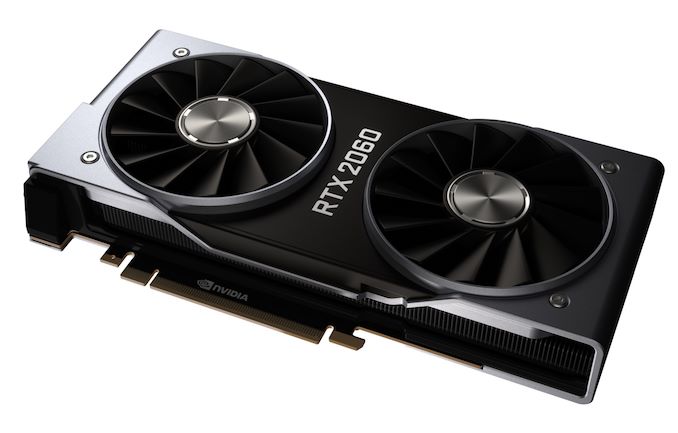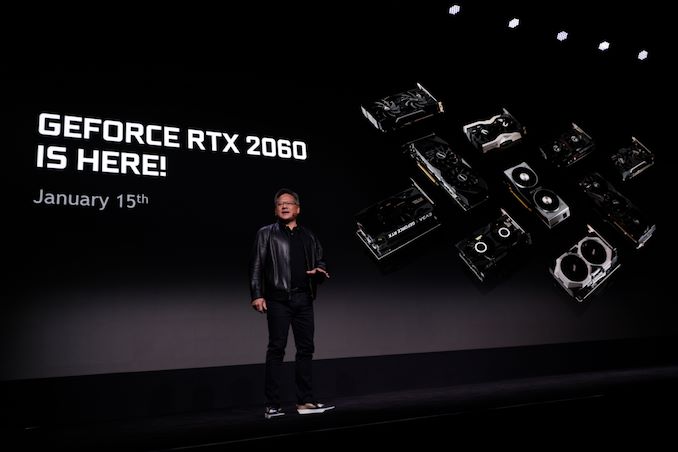The NVIDIA GeForce RTX 2060 6GB Founders Edition Review: Not Quite Mainstream
by Nate Oh on January 7, 2019 9:00 AM ESTClosing Thoughts
As we bring this to a close, we are again revisiting the central themes of the GeForce RTX 20 series across the launches: forward-looking featuresets that are not widely available, premium pricing based on those hardware features, and competition with existing Pascal products due to comparable conventional gaming performance. This time, however, the last two have played out a little differently. Pascal-based GTX 1080, 1070 Ti, and 1070s are not so readily available and/or are at higher prices. And although the price premium pushes the GeForce RTX 2060 (6GB) out of the traditional mainstream home of the x60 part, it puts it firmly in contention against the Radeon RX Vega cards and to a lesser extent the recently-launched Radeon RX 590.
As a whole, in developing Turing and the GeForce RTX 20 series, NVIDIA has invested heavily in hybrid rendering, offering less price-to-performance for conventional gaming than usual for new GPU architectures. This has been compounded by excess Pascal inventory, a result of the cryptocurrency mining demand of the past year or two. The RTX 2060 (6GB) is no exception, and while it is a better price-to-performance offering relative to its older siblings, it’s simply no longer a ‘mainstream’ video card at $350, instead occupying the ‘value-enthusiast’ space.
For conventional gaming, if the RTX 2080 is akin to the GTX 1080 Ti and the RTX 2070 like the GTX 1080, then the RTX 2060 (6GB) truly performs like the GTX 1070 Ti. By the numbers, the RTX 2060 (6GB) is 2-3% faster than the GTX 1070 Ti at 1440p and 1080p, though comparison becomes a wash at 4K. In turn, reference-to-reference the RTX 2060 (6GB) is around 11% faster than the RX Vega 56 at 1440p/1080p, narrowing to 8% at 4K. There are hints that the 6GB framebuffer might be limiting, especially with unexpectedly low 99th percentile framerates at Wolfenstein II in 4K, though nothing to the extent that older 4GB GTX 900 series cards have experienced.
Potential VRAM bottlenecks is something that needs further investigation, but more to the point, this is a $350 card featuring only 6GB VRAM. Now it is admittedly performing 14-15% ahead of the 8GB GTX 1070, a card that at MSRP was a relatively close $379, but it also means that NVIDIA has essentially regressed in VRAM capacity at this price point. In terms of the larger RTX lineup, 6GB is a bit more reasonable progression compared to the 8GB of the RTX 2070 and RTX 2080, but it is something to revisit if there are indeed lower-memory cut-down variants of the RTX 2060 on the way, or if games continue the historical path of always needing more framebuffer space. The biggest question here isn't whether it will impact the card right now, but whether 6GB will still be enough even a year down the line.
Generationally, the RTX 2060 (6GB) does bring more to the table, offering roughly 86% of the performance of the RTX 2070 for 70% of the price. Or against its direct predecessor, the GTX 1060 6GB, it’s faster by around 59%. In context, the GTX 1060 6GB was 80-85% faster than the GTX 960 (2GB) at launch, where presently that gap is more along the lines of 2X or more, with increased framebuffer the primary driver. But at $200, the GTX 960 was a true mainstream card, as was the GTX 1060 6GB at its $249 MSRP, despite the $299 Founders Edition pricing.
What makes the $350 pricing at least a bit more reasonable is its Radeon competition. Against RX Vega at its current prices the RTX 2060 (6GB) is near-lethal, so if AMD wants to keep their Vega cards as viable market competitors, they are going to have to reduce prices. Reference-to-reference, the RTX 2060 (6GB) is already bringing around 95% of RX Vega 64 performance, so card pricing will make all the difference. The same goes for the RX 590, whose position in the ‘performance gap’ between the RX Vega 56 and RX 580 is now shared. And alongside potential price changes, there are still the value-adds of game bundles and FreeSync compatibility.
At least, that would have been the straightforward case for AMD if not for yesterday’s announcement of game bundles for RTX cards, as well as ‘G-Sync Compatibility’, where NVIDIA cards will support VESA Adaptive Sync. That driver is due on the same day of the RTX 2060 (6GB) launch, and it could mean the eventual negation of AMD’s FreeSync ecosystem advantage.
Like the RTX 2070, the RTX 2060 (6GB) is less suited as an option for most high-end GTX 10 series owners, and with 6GB VRAM as it’s a little less tempting than it could be as a move up from the GTX 1060 6GB or GTX 980 Ti. The card offers known performance along the lines of the GTX 1070 Ti and at very similar power consumption, but brings better value than existing higher-end RTX 20 series models. And this time, there’s less of a spoiler effect from older Pascal models.
Compared to previous generations, it’s not breaking the price-to-performance curve, as it is still an RTX card and pulling double-duty as the new entry-point for RTX platform support. That being said, there is no mincing words about the continuing price creep of the past two GeForce series. The price-to-performance characteristics of the RTX 2070, 2080, and 2080 Ti is what renders the RTX 2060 (6GB) a better value in comparison, and not necessarily because it is great value in absolute terms. But as an upgrade from older mainstream cards, the RTX 2060 (6GB) price point is a lot more reasonable than the RTX 2070’s $500+, where there more of the price premium is from forward-looking hardware-accelerated features like realtime raytracing.
So the RTX 2060 (6GB) would be the most suitable for gamers that aren’t gung-ho early adopters or longtime enthusiasts. The caveat is on the 6GB framebuffer, keeping in mind that the 4GB GTX 980 and 970 now punch below their weight in certain games, given the trends of HDR, HD texture packs, high-refresh rates, and more. Beyond that, the RTX 2060 (6GB) and RTX 2070 comes with a choice of Anthem or Battlefield V, as part of the new bundle. For a prospective buyer, this might not justify $500 but might outweigh $350, especially as realtime raytracing can be immediately tried out with Battlefield V. In the same way, upcoming support for adaptive sync could do the same for those looking to upgrade to a monitor with variable refresh rate.













134 Comments
View All Comments
sing_electric - Monday, January 7, 2019 - link
It's likely that Nvidia has actually done something to restrict the 2060s to 6GB - either though its agreements with board makers or by physically disabling some of the RAM channels on the chip (or both). I agree, it'd be interesting to see how it performs, since I'd suspect it'd be at a decent price/perf point compared to the 2070, but that's also exactly why we're not likely to see it happen.CiccioB - Monday, January 7, 2019 - link
You can't add memory at will. You need to take into consideration the available bus, and as this is a 192bit bus, you can install 3, 6 or 12 GB of memory unless you cope with hybrid configuration thorough heavily optimized drivers (as nvidia did with 970).nevcairiel - Monday, January 7, 2019 - link
Even if they wanted to increase it, just adding 2GB more is hard to impossible. The chip has a certain memory interface, in this case 192-bit. Thats 6x 32-bit memory controller, for 6 1GB chips. You cannot just add 2 more without getting into trouble - like the 970, which had unbalanced memory speeds, which was terrible.mkaibear - Tuesday, January 8, 2019 - link
"terrible" in this case defined as "unnoticeable to anyone not obsessed with benchmark scores"Retycint - Tuesday, January 8, 2019 - link
It was unnoticeable back then, because even the most intensive game/benchmark rarely utilized more than 3.5GB of RAM. The issue, however, comes when newer games inevitably start to consume more and more VRAM - at which point the "terrible" 0.5GB of VRAM will become painfully apparent.mkaibear - Wednesday, January 9, 2019 - link
So, you agree with my original comment which was that it was not terrible at the time? Four years from launch and it's not yet "painfully apparent"?That's not a bad lifespan for a graphics card. Or if you disagree can you tell me which games, now, have noticeable performance issues from using a 970?
FWIW my 970 has been great at 1440p for me for the last 4 years. No performance issues at all.
atragorn - Monday, January 7, 2019 - link
I am more interested in that comment " yesterday’s announcement of game bundles for RTX cards, as well as ‘G-Sync Compatibility’, where NVIDIA cards will support VESA Adaptive Sync. That driver is due on the same day of the RTX 2060 (6GB) launch, and it could mean the eventual negation of AMD’s FreeSync ecosystem advantage." will ALL nvidia cards support Freesync/Freesync2 or only the the RTX series ?A5 - Monday, January 7, 2019 - link
Important to remember that VESA ASync and FreeSync aren't exactly the same.I don't *think* it will be instant compatibility with the whole FreeSync range, but it would be nice. The G-sync hardware is too expensive for its marginal benefits - this capitulation has been a loooooong time coming.
Devo2007 - Monday, January 7, 2019 - link
Anandtech's article about this last night mentioned support will be limited to Pascal & Turing cardsRyan Smith - Monday, January 7, 2019 - link
https://www.anandtech.com/show/13797/nvidia-to-sup...